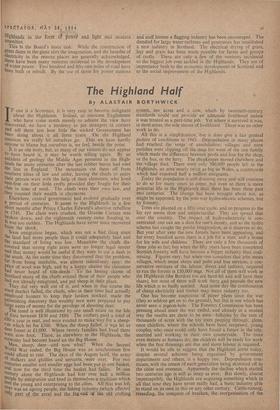Power from the Glens
By A CORRESPONDENT THANKS largely to the passionate insistence of the then Secretary of State for Scotland, Mr. Tbm Johnston, the North of Scotland Hydro-Electric Board was set up in 1943. Six years later the first of its turbines were turning. Since then its generating capacity has more than quadrupled.
For the Highlands this means a better standard of living. more facilities, more opportunities for enterprise at home– and less emigration. In the past five and a half years more than half the number of consumers who were without electricitY in the Board's supply area—three-quarters of the land area of Scotland—have been connected to the mains, at the rate of twenty thousand a year. In 1948 only one farm in fourteen and one croft in a hundred had electricity: today one far01 in three and one croft in three have a supply. This has helped to keep labour on the land and so to increase food production. More than five hundred villages, hamlets and new housing areas have been supplied for the first time. Over two hundred industrial concerns are now better equipped with mains electricity. Eight thousand workers are directly employed on the building of dams, power stations and distribution lines, and this is a total that will be maintained for many years. In spite of the rapid growth of the Board's activities there is still a shortage of power—the effect, mainly, of the capital cuts made in 1949. But more construction is in hand and the rate of hydro-electric production should be doubled during the present decade. Still further development will be needed, because the demand for electricity in the Board's area has more than doubled in the past ten years, and there is no sign that saturation has been reached.
But not all of the Board's production' is used in the Hier lands. The Sloy power station on the banks of Loch Lomond, for example, was designed to export up to 130,000 kilowatts of power to the Glasgow area at peak load periods. The profit from the sale of this power to the British Electricity AuthoritY, goes to extend electricity distribution in the sparsely populate' areas of the north. Thus the latent resources of the Highlands in water power, which used to pour unused into the sea, all now being harnessed and the profits ploughed back into th°
Highlands in the form of power and light and modern amenities.
This is the Board's main task. While the construction of great dams in the glens stirs the imagination, and the benefits of electricity in the remote places are generally acknowledged, there have been many ventures incidental to the development of water power. Two hundred and fifty-one miles of road have been built or rebuilt. By the use of stone for power stations
and staff houses a flagging industry has been encouraged. The demand for large water-turbines and generators has established a new industry in Scotland. The electrical drying of grass, , hay and grain has been made possible for farms and groups of crofts. These are only a few of the ventures incidental to the biggest job ever tackled in the Highlands. They are of importance both to the economic development of Scotland and to the social improvement of the Highlands.



































































 Previous page
Previous page